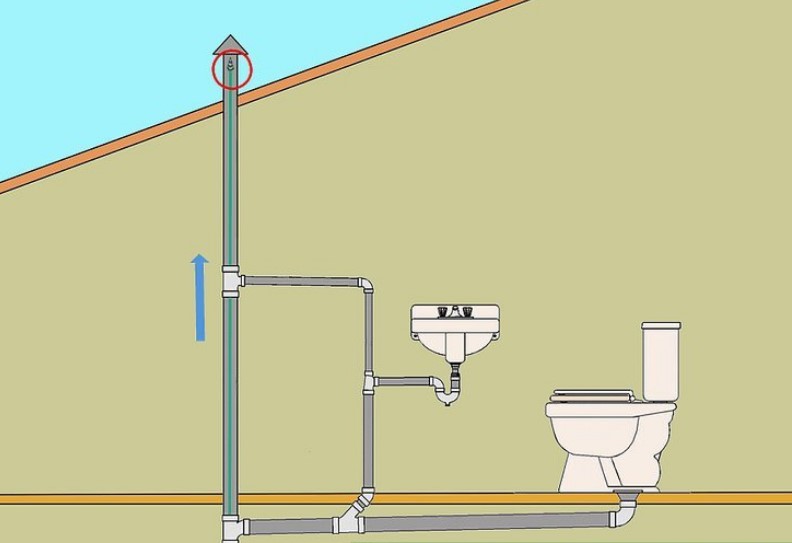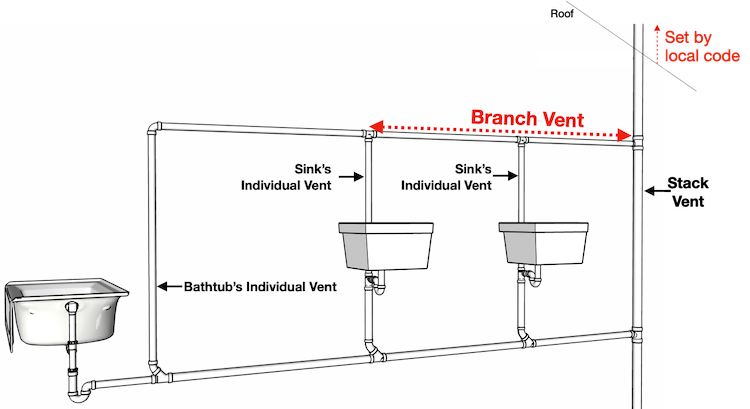How Proper Ventilation is Essential for Plumbing Systems
How Proper Ventilation is Essential for Plumbing Systems
Blog Article
Presented here below you can locate lots of first-rate details in regards to What Are Plumbing Vents and Why Are They Important?.

Proper ventilation in pipes systems is typically forgotten, yet it is essential for preserving the performance and safety of your home's plumbing. Air flow aids regulate atmospheric pressure, avoid the buildup of harmful gases, and make certain the effective elimination of waste. In this guide, we will explore the value of appropriate plumbing air flow, just how it functions, and the benefits it gives your plumbing system.
Exactly How Ventilation Functions in Plumbing Solutions
Atmospheric Pressure Policy
Proper air flow preserves balanced atmospheric pressure within the pipes system. When water streams via pipelines, it displaces air. Without ample ventilation, this variation can produce adverse stress, leading to slow down drains or siphoning of water from catches, which can trigger undesirable odors to permeate right into the home.
Protecting Against Sewage System Gas Build-up
Among one of the most important functions of pipes vents is to avoid drain gases, such as methane and hydrogen sulfide, from building up within the home. These gases can position significant health and wellness risks and are very flammable. Vent pipes enable these gases to get away securely outdoors.
Helping in Waste Elimination
Ventilation helps in the effective removal of wastewater by avoiding airlocks in the drain system. When air can stream freely with the vents, it enables water and waste to stream efficiently with the pipelines, lowering the threat of obstructions and backups.
Advantages of Proper Ventilation
Improved System Effectiveness
Appropriately aerated plumbing systems run much more efficiently, with less obstructions, faster draining, and much less pressure on the pipes. This efficiency expands the life expectancy of the plumbing system.
Improved Air Quality
By stopping sewer gases from entering your home, proper air flow contributes to much better interior air high quality, making your living setting healthier and much more comfy.
Stopping Water Damage
Sufficient air flow assists stop water from being siphoned out of traps, which can cause drain gases getting in the home and creating water damages over time.
Actions to Make Certain Correct Air Flow
Consulting Plumbing Codes
Constantly seek advice from regional pipes codes when making or modifying your plumbing system. These codes provide the needed standards for proper venting and guarantee your system satisfies safety and security standards.
Regular Inspection and Upkeep
Normal assessments can help determine potential ventilation concerns before they end up being significant troubles. Maintenance tasks, such as cleansing air vent pipelines and checking for obstructions, are crucial for keeping the system in good working order.
Professional Setup
For new installments or significant alterations, it's important to work with a specialist plumbing. They have the expertise to ensure the air flow system is correctly developed and set up according to code.
Understanding Ventilation in Pipes
Air flow in plumbing refers to the network of pipelines that allow air to move through the water drainage system. These vents offer multiple purposes, consisting of managing air pressure within the pipes, avoiding sewage system gases from going into the home, and aiding in the smooth circulation of wastewater.
Kinds Of Pipes Vents
Main Stack Vent
The major pile vent, likewise referred to as the air vent stack, is the primary air vent in a plumbing system. It prolongs from the major drain line up via the roof covering, allowing gases to escape and fresh air to get in the system.
Branch Vent
Branch vents attach to the primary pile air vent and serve specific components, such as sinks, commodes, and showers. These vents ensure that each fixture has adequate ventilation to work effectively.
Air Admission Shutoff (AAV).
An Air Admittance Valve (AAV) is a one-way shutoff that allows air to enter the plumbing system without the need for a typical vent pipeline expanding with the roofing system. AAVs are generally made use of in remodellings or locations where setting up a common air vent is impractical.
Signs of Poor Ventilation in Pipes.
Slow Draining Fixtures.
If your sinks, tubs, or bathrooms are draining gradually, it could be a sign of bad air flow. Poor air flow can develop a vacuum result, making it difficult for water to drain appropriately.
Gurgling Seems.
Gurgling audios coming from drains are commonly an outcome of air being drawn via water catches due to unfavorable pressure in the pipelines. This is a clear indication of inadequate ventilation.
Undesirable Smells.
Sewage system smells inside your home are a red flag that your plumbing system is not correctly aerated. This could mean that drain gases are not being effectively aired vent outside, leading to potentially dangerous conditions.
Usual Air Flow Blunders.
Poor Vent Sizing.
Utilizing undersized air vent pipelines can result in bad air flow and stress discrepancies in the system. It's vital to utilize vents that fulfill the details needs of your pipes system.
Improper Vent Positioning.
Positioning vents too far from the fixtures they serve can minimize their efficiency. Proper positioning makes certain that air can move easily and successfully through the system.
Ignoring Code Needs.
Building ordinance offer details guidelines for pipes air flow. Disregarding these codes can result in a system that falls short to function properly and might bring about costly repair work or carcinogen.
Conclusion.
Appropriate air flow is a crucial element of any kind of plumbing system, making certain that it works successfully and safely. By recognizing the importance of air flow, identifying the indications of inadequate ventilation, and taking actions to preserve your system, you can prevent expensive problems and secure your home's air quality.
4 Things You Should Know About Your Plumbing Vents
What Plumbing Vents Are
Also called a vent stack, a plumbing vent is a vertical pipe attached to your drain line that runs through your roof. The plumbing vent pipe, or plumbing air vent, removes gas and odors from your plumbing system and allows fresh air to enter the pipes, helping the water to flow out of the drain pipes.
What Plumbing Vents Do
Plumbing vents have two basic functions. One of which is to allow unpleasant smelling wastewater and sewer gasses to escape your plumbing system instead of entering your home. Plumbing vent pipes are typically located on roofs, away from windows, to ensure the fumes exit the home completely.
The other function of the plumbing vent is to move fresh air into your plumbing system. This helps move water through every plumbing fixture in your house, like toilets and sink drains. Think of the way in which you need to let a little air into the bottle as you pour soda in order to make the drink flow smoothly.
Different Types of Plumbing Vents
True vent: This is the most common vent option. In simplest terms, a true vent is a vertical pipe attached to your drain line that exits through the roof. They often function as the main vent that other fixtures can connect to. Re-vent pipe or auxiliary vent: Attached to the drain line near specific plumbing fixtures, re-vent pipes run up and over to connect to the main vent. Common vent: Two plumbing fixtures installed on opposite sides of a wall are typically tied into the vent stack using something known as a sanitary cross. Wet vent: This venting option operates as a drain pipe and a vent at the same time. Wet vent drainage systems drain water from one fixture while venting the air from another. Although they’ve been used for over 100 years, wet vent systems have only recently been added to the plumbing code in many areas. If you’re planning on installing one in a bathroom remodel, make sure you check your local code prior to construction. Loop vent: For free-standing fixtures like kitchen island sinks, loop vents are ideal. These vent pipes run under the floor, rise from the P-trap, and create a loop inside the cabinet sink. Air admittance valve: An AAV is a one-way mechanical valve typically installed at the site of the plumbing fixture. AAVs allow venting to occur without having to tie into a larger venting system. They’re ideal for venting fixtures where you aren’t able to easily connect to an existing vent system. Common Plumbing Vent Issues
Although vent pipes typically don’t have water flowing through them, they’re still subject to many typical plumbing issues. For example, clogs are one of the most common problems associated with sewer vent pipes. If your vent pipe gets clogged, all of your plumbing fixtures tied into the vent stack will be affected.
A sink with a slow drain that bubbles and gurgles or a strong sewage smell around your toilet are both indicators that your toilet vent pipe is clogged. Because most vent pipes exit through the roof, old leaves, twigs or even a bird’s nest could be clogging the pipe.
Clogs in your vent pipe system cause a buildup of negative pressure, meaning that water won’t be able to flow out of your home very well. It’s similar to putting your finger over the opening of a straw to trap water inside. When you remove your finger, the water is able to flow out of the straw.
If you suspect you have any blockage in your vent, make sure you have a professional come examine the situation. Left unchecked, a blocked air vent can lead to other costly repairs, like leaks and sediment buildup.
Under Pressure
Pipe vents are essential aspects of a home’s plumbing system. Owning a home means learning about all sorts of things you never put much thought into before. But by understanding as much as you can about the important systems of your home, you can keep those budgets intact and those anxiety levels low.
https://www.homeserve.com/en-us/blog/home-improvement/plumbing-vents/

Hopefully you enjoyed our excerpt about What Is a Plumbing Vent and Why Is It Important. Thanks so much for finding the time to browse our piece. Are you aware of another person who is interested by the topic? Why not promote it. Thanks a lot for your time. Revisit us soon.
Request Free Estimate Report this page